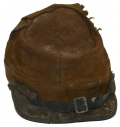site search
online catalog
REGULAR ARMY CIVIL WAR ENLISTED KEPI WITH INDIAN WAR USE FROM FORT PEMBINA, NORTH DAKOTA

$2,250.00
Quantity Available: 1
Item Code: 1052-252
Shipping: Determined by Method & Location of buyer
To Order:
Call 717-334-0347,
Fax 717-334-5016, or E-mail
This Civil War enlisted man’s kepi comes from the excavations at Fort Pembina, ND, conducted on private property with the owner’s permission, and is in a remarkable state of preservation from the anaerobic conditions of the soil. The fort was established in 1870 by troops of the 20th US Infantry and as is typical of the early Indian Wars regular army, their issue uniforms and gear were wartime surplus and even a privately purchased cap like this might be a hold-over from wartime service or a retailer’s inventory. The cap has the typical inset crown of the kepi form, with the front rising about 3” from the top of the visor, along the lines of the “McClellan” style cap, making it neater and more fashionable than the baggy, issue M1858 forage cap, but more comfortable than rather too trim chasseur style caps that inspired the M1872, which remained regulation into the 1890s. The cap has 1 ½” band around the base. There is no lining left, but the sweatband and the leather stiffener inside the crown are in place. The visor is flat, with a bound edge, typical of nicer, privately purchased caps. The chinstrap remains as well, secured on one side by a small eagle button. It is 5/8” wide and adjusted by a loop at the end of each half of the strap and friction buckle acting as a stop against them. This is the typical issue style of chinstrap, but shows up on some privately purchased caps as well.
The cap retains its form and displays very well. The fabric remains fairly supple and has shifted in color to a light brown. The front and forward sides are very good. The back shows some tears and holes on the upper half, but also what seem to be intentionally made slits, likely a made for comfort by the wearer, either in terms of size or ventilation. (Collectors will be familiar with slits made to issue military shoes, likely for the same reasons.)
Any Civil War or even Indian War cap with real use by the Regulars is scarce. Finding one actually used on the western frontier is especially tough.
Fort Pembina, situated in the Red River Valley in North Dakota near the Canadian border, was established in 1870 and in operation until 1895. Trading posts existed earlier in the area as part of the fur trade, and the first U.S. military post there was temporary- manned by a detachment of Minnesota troops in 1863-1864 following the 1862 Sioux uprising. In March 1870 a new fort was established south of the Pembina River and about 200 yards west of the Red River, completed by July and named in honor of Gen. George H. Thomas. The name was changed to Fort Pembina in September and the initial garrison consisted of two companies of the 20th US Infantry. Their main duty was to provide security for settlers worried about Sioux returning south from Canada, but the troops were more occupied with escorting boundary surveys along the Canadian border and preventing Fenian raids heading north into Canada.
The fort included enlistedmen’s barracks, officers’ quarters, guard house, ordnance storehouse, company kitchen, root house, laundress’s quarters, quarters for civilian employees, hospital and hospital servant’s house, a barn for the “hospital cow,” quartermaster and commissary offices and storehouse, stables, wagon shed, etc. The garrison reached peak strength in 1878 af 200, but the average was about 125 enlisted men and 8 officers. An October 1885 return listed 97 men, 2 field pieces, 1 mountain howitzer, 100 rifles, 19 pistols, 23 mules, and 9 wagons. By 1890 the post had just 23 men, and after an 1895 fire destroyed some 19 buildings it was decided to abandon the fort rather than rebuild, the last detachment left in September. The property was turned over to the Interior Department and later sold in 1902.
This is a scarce relic, actually worn at a small frontier fort, and likely dates early in the fort’s history. [sr][ph:L]
~~~~~~~~~~~~~~~~~~~~~~~~~~~~~~~~~~~
THIS ITEM, AS WITH ALL OTHER ITEMS AVAILABLE ON OUR WEB SITE,
MAY BE PURCHASED THROUGH OUR LAYAWAY PROGRAM.
CLICK HERE FOR OUR POLICIES AND TERMS.
THANK YOU!
Inquire About REGULAR ARMY CIVIL WAR ENLISTED KEPI WITH INDIAN WAR USE FROM FORT PEMBINA, NORTH DAKOTA
For inquiries, please email us at [email protected]
Most Popular
Historical Firearms Stolen From The National Civil War Museum In Harrisburg, Pa »
Theft From Gravesite Of Gen. John Reynolds »
Selection Of Unframed Prints By Don Troiani »
Fine Condition Brass Infantry Bugle Insignia »
British Imported, Confederate Used Bayonet »
Scarce New Model 1865 Sharps Still In Percussion Near Factory New »
featured item
RARE M1840 U.S. ARTILLERY OFFICER’S SABER MADE BY AMES BUT ETCHED AND RETAILED BY SCHUYLER, HARTLEY AND GRAHAM: THE ONE IN THE BOOK!
This is an extremely rare M1840 U.S. artillery officer’s saber made by Ames but etched and retailed by Schuyler, Hartley and Graham. Thillmann knew only of this one example, and until it was found it was unclear if Schuyler, Hartley and Graham… (870-637). Learn More »
site search
Upcoming Events
May 16 - 18: N-SSA Spring Nationals, Fort Shenandoah, Winchester, VA Learn More »







